Bega Valley
Atmosphere & Weather | Biodiversity | Catchments | Resources Use
Summary of updates to Bega Valley indicators for 2008-09.
Bega Valley Snapshots
These "snapshot" profiles celebrate recent environmental initiatives within this LGA.
Archive of 2008 snapshots for Bega Valley.
2009 Snapshots
1. Protecting Sites of National Significance – Genoa River Blackberry and Willow Control Program
2. Close Co-operation Benefits Control of Blue Hound’s Tongue Weed
Protecting Sites of National Significance – Genoa River Blackberry and Willow Control Program
The Genoa River Interstate Liaison Committee (GRILCO) undertook an integrated total catchment management program to control blackberries and willows from 2006 – 2009.
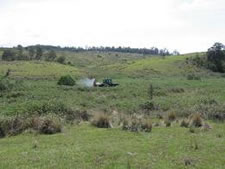
Nungatta blackberry spraying
The project targeted blackberries and willows within the Genoa and Wallagaraugh River catchments. Both of these catchments include Sites of National Significance.
The project was facilitated by GRILCO, an interstate committee involving partnerships with industry, Victorian and New South Wales (NSW) Government agencies, including Bega Valley Shire Council and private landholders. The project was successful due to close cooperation between all parties and a flexible approach to tackling the issues which accounted for weather conditions, land management issues, funding opportunities and land uses.
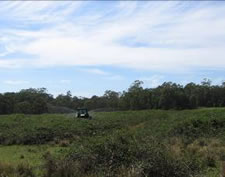
Nungatta blackberry spraying
The project targeted heavily infested sites in the upper catchment, trialling innovative and conventional techniques and adapting current best management practice guidelines for blackberry and willow control. The project was publicised through field days, an extensive education and awareness program, and a comprehensive media campaign.
The project acted as a trial site for rust release as a part of Dr Louise Morin’s (CSIRO) project: ‘National blackberry biological control program in partnership with the community’. The success of biological control of blackberries, despite setbacks caused by dry conditions, will inform other blackberry control strategies that include herbicide control, stock and native and introduced pasture management, vegetation rehabilitation and the establishment of wildlife corridors to promote movement of native plants and animals.
Close Co-operation Benefits Control of Blue Hound’s Tongue Weed
Blue Hound’s Tongue is a declared noxious weed in Bega Valley and it is on the National List of Alert Weeds. An invasive weed, it can grow up to 600mm high and is toxic to livestock. It has a history of infestation near Eden and currently there is an infestation in the Towamba Valley in Bega Valley.
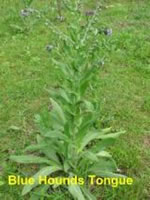
Blue Hound’s Tongue Weed,
with its Small Blue Flowers
Photo: Bega Valley Shire Council
The last known infestation in the Towamba Valley was targeted under a Natural Heritage Trust (NHT) funded project in 2005/06. However, in 2008/09, a further infestation ten kilometres downstream was discovered. This led to a targeted and extensive control program commencing December 2008. The New South Wales (NSW) Department of Primary Industries (DPI) provided emergency funding for the program.
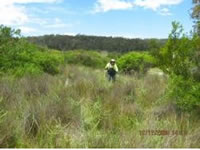
Removing the Weed
Photo: Bega Valley Shire Council
Blue Hound’s Tongue is often dispersed when seeds attach to people and animals. However, it is not known how the weed was transported between sites along the Towamba River, as local animals do not tend to travel long distances. One suggestion is that it may have been transported by feral deer.
The land, located at the mouth of the Towamba River on Twofold Bay, belongs to the Eden Local Aboriginal Land Council (LALC), It is also a camping ground, which is generally crowded over the summer holiday period.
The camping community became involved in the project with an extensive education and awareness program conducted by several long term campers in conjunction with Council weeds officers. This program involved long term campers providing information to others at the site by way of identification and also through the provision of brochures and bags for weed collection and disposal. Community involvement continued throughout the summer.
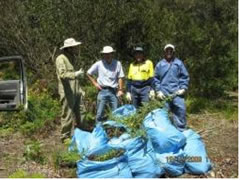
The team and their haul
Photo: Bega Valley Shire Council
This infestation was confined to a small area, allowing quick and effective actions. Bega Valley is planning follow-up control work, along with surveying and mapping so that this weed can be completely eradicated in the long-term. Education activities with adjoining landholders have also commenced.
Blue Hound's Tongue is often discovered accidentally. While this may be regarded as a positive, it also indicates that other infestations of Blue Hound's Tongue may occur elsewhere in the region. This is a concern given the physical characteristics and invasiveness of the weed.
Early detection and eradication are important in preventing the spread of Blue Hound’s Tongue. Small infestations can be easily eradicated if they are detected early but there is a need for an ongoing commitment to prevent new infestations.
Close cooperation by all parties allowed this project to progress quickly, with the Eden LALC and Indigenous work crews carrying out extensive works. The work crews received assistance from Council weeds officers, Council contractors, Department of Primary Industry personnel, Southern Rivers Catchment Management Authority officers, NSW Maritime and private landholders.. This project demonstrates the benefits of close cooperation. With community assistance, , we may one day see its permanent removal from Bega Valley.
